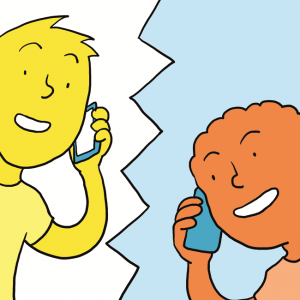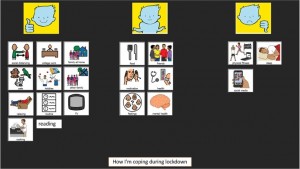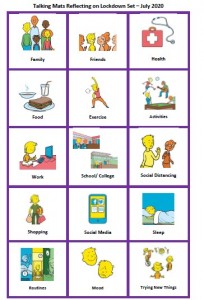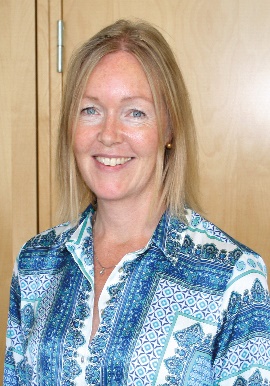Our first Talking Mats advanced online module has launched. We are pleased we had developed our online foundation training well before lockdown. There has been such great feedback from people who have completed our online foundation course and they have been asking for more. They like the bite size chunks, being able to pace their own learning and the reflective practice approach. Now we are adding to our online course with an advanced Talking Mats module focusing on Talking Mats use in safeguarding. This course is structured around the Talking Mats Keeping Safe resource and how to use it.
The Keeping Safe Talking Mats resource was developed to check in with people and find out how their lives are going. It uses a holistic framework to do this and the conversation it supports is structured around three topics: 1) well-being; 2) relationships; 3) thoughts and feelings. The resource was trialled and tested in projects involving over 700 practitioners. Originally, it was designed for people with learning disabilities but feedback has been that it has been helpful with a wide range of people including, those with stroke, head injury, dementia and mental health issues.
The advanced online module involves 2 to 3 hours of learning that you do at your own time and pace. It involves short talks, reading, videos and reflective practice activities. You will develop confidence in using the resource as well as an understanding of relevant issues, such as diagnostic overshadowing, developing the capacity of individuals to raise concerns, the impact of trauma. You will be encouraged to reflect on how you can apply the Talking Mats Keeping Safe resource to your own area of practice
To apply for the course, you must have completed your foundation Talking Mats training. If you haven’t completed this training book now. Access to this advanced course will begin on the first of every month and you will have 6 weeks to complete it.
Book your place now. The cost is £85 for the course and the Keeping Safe resource and £55 if you already have your Keeping Safe resource and just want to do the training.
I am passionate about connection, about communication, about music. That’s what drives me forward. I have been playing the cello for over 40 years; I’ve been playing professionally for about 25 years. Having the privilege and honour of playing at the bedside of people who I cared about who were nearing the end of their life changed my perspective on the importance of music. I realised that there was far more to music and to my playing the cello than ‘performing’ – than my ego. I learned that music could touch all who were involved; listeners and musicians alike in a deeply profound way – but I wasn’t sure quite HOW to harness music in an effective manner to insure I was not simply performing. This realisation took me into a wonderful course in the USA – ‘Music and Transitional Healing Program’ (MHTP.org) back in the early 2000s. I found what I’d been looking for – I learned about different types of music and rhythms and modes and when to play them depending solely on the state of the listener. I learned about entrainment and other very important tools in order to better ensure that all important connection with the listener. I learned to meet the listener where they are in the THAT moment – to aim to get in sync with them – and to then respond to whatever happens.
This learning eventually and unexpectedly led me to a PhD studentship at the University of Stirling where I played the cello live and pre-recorded at the bedsides of care home residents with dementia who were in palliative care, and someone who was closely connected with them. I wanted to know how the recorded vs live music might affect the listener’s connection with one another.
During my PhD, I trained in Talking Mats – I have since bought quite a few of the packs available and remain convinced regarding the effectiveness of this simple tool for enhancing connection and communication.
Now I am moving into the virtual world that we all find ourselves in. Lock-down has allowed me to have more time to fully enjoy playing my cellos (I specialise in baroque cello as well as modern cello – and I have a 6-string electric cello as well!). This strange gap in time has also prompted me to finally building a (still evolving) website (https://drclairegarabedian.com/) and to schedule events related to my work with music and people living with dementia (https://drclairegarabedian.com/events/). Although I have previously offered similar events live, this will be a new experience/learning curve in the virtual world!
I am currently managing a wonderful project through the Edinburgh InterFaith Association (https://www.edinburghinterfaith.com/time-to-talk); ‘Time to Talk’ – this Covid-19 listening service is funded Scottish Government funded through July 2020, and provides a skilled, trained, experienced listener for all care home residents and their families living in Scotland (11:00am – 7:00pm, 7 days a week).
I hope to see you at one of my upcoming events – please sign-up on my website for news of upcoming events and offers. Stay safe and healthy everyone!
Thanks to Claire Garabedian fro this guest blog and good luck from all of us in her new venture
I stole the lyrics and altered them slightly, but this is the song line that has kept popping into my head over the past few weeks as we find ourselves hurtling through the different phases of lockdown easing. The rules and recommendations that have guided our lives for the past 3 months or so are changing rapidly and change can be difficult. Communicating how we feel about change and life in general can be difficult.
We have seen creative uses of our resources and have really enjoyed learning how they have helped young people and adults express how they coped throughout lockdown and beyond. Kirsten Lamb’s guest blog about Returning to School After Lockdown is just one example of how the TM framework was invaluable in gaining the opinions of young people as they adapted to ongoing changes over which they had little or no control.
https://www.talkingmats.com/returning-to-school-after-lockdown/
Another Talking Mats practitioner recently tweeted this mat that she did with a college student, showing how Talking Mats helped structure thinking about how life was going.
We felt a single resource was needed to help kick start a conversation around Life (but not as we know it; I am sure that’s a song too) looking at the following themes:
- Family / Friends / Bubbles / Social Distancing
- Health
- Mood / Emotion
- Sleep
- Exercise
- Work
- School / College
- Activities
- Shopping
- Routine
As with every Talking Mat you can change the top scale to be more or less concrete, you can use blanks to add in things that we haven’t included, you can leave things out that aren’t relevant. Download your free printable pdf here: LOCKDOWN SET
We look forward to hearing stories from our Talking Mats Community on how you helped others express themselves (definitely another song!)
Thanks to everyone who joined our second Zoom session on using Talking Mats remotely. The notes from the first session can be found here. It was great to share experiences and to welcome our international Talking Mats’ community too. We were impressed by your ingenuity and creativity in making TMs work remotely and there were lots of great stories of the use of it in practice. Here is a summary of the main points, with special thanks to Sam Quinn for explaining how to use 2 devices in order to see the person as well as the Mat.
Using a second device on a virtual Talking Mat session can help you to capture the thinker’s reaction to the mat and symbols. This can be particularly useful for recording videos to watch again later (obviously with the appropriate video consent). To do this on a tablet or mobile device and assuming you have already set up the meeting:
1. Open the Talking Mat app on your first device and prepare the symbol set you would like to use. When you are finished, minimise this app.
2. On the same device, open your communication app (Zoom, Microsoft Teams) and join your meeting.
3. Click ‘share’ and ‘screen’, then switch to the Talking Mats app. You should be able to control the Talking Mat while other people in the meeting can see it. It is advised you mute your volume to avoid interference.
4. On your second device (this could be a laptop, tablet or mobile) use the meeting ID that you sent to yourself to join the Zoom meeting.
5. On your second device, there is an option to split the screen so you can see both the thinker and the Talking Mat at the same time.
6. If you are using a PC or laptop as your second device there may be an option to record the session if you wish to do so.
Device one (tablet or mobile) hosts the Zoom/Teams meeting and is used to control the Talking Mat.
Device two (tablet, mobile or PC) acts as a second guest in the meeting and allows you to view the Mat and the thinker at the same time and record the session.
You can invite another device using Near Me/Attend Anywhere.
Remember you can still use the physical resources by holding the Mat to the camera and asking the thinker to tell you where to place the option on the Mat. Some have done this successfully.
You can try iPad mirroring https://tactustherapy.com/telepractice-how-to-mirror-apps-computer/ You can download a guide for how to do this if you follow the link.
A couple of people reported setting up Talking Mats by using https://miro.com/ and https://jamboard.google.com/ but, word of warning, it takes time to do this.
Remember you can use your digital login for the app (from Apple Store) and through the web browser http://www.digitaltalkingmats.com/ – make sure you enable FLASH.
And finally just to remind you that you can currently get a discount on the Digital Talking Mats resource:
DISCOUNTED DIGITAL TALKING MATS REQUEST FORM
Our online Foundation training is taking place throughout the year. Forthcoming courses are starting on 22nd September, 6th October and 3rd November. Reserve your place here.
If this is all new to you and you want to find out more about it, please listen to a webinar arranged by the Health and Social Care Alliance where Margo and Lois talk about Digital Talking Mats and how it can support wellbeing: https://www.youtube.com/watch?v=84CY3QFFa_g
Youth Justice Research
How can Talking Mats be used in youth justice research? I am a clinical psychology doctoral student at the University of Auckland, New Zealand. My doctoral research is an evaluation of communication assistance in our youth justice system. Communication assistance is New Zealand’s version of the England and Wales intermediary scheme. I used a Talking Mat framework to help understand young people’s experiences of working with a communication assistant.
I first learnt about Talking Mats in 2017 when I attended a workshop on enabling effective communication with children and young people run by Talking Trouble Aotearoa New Zealand (www.talkingtroublenz.org). I have since attended Talking Mats training in New Zealand and have regularly used Talking Mats in my previous work as an intern psychologist at a Child and Adolescent Mental Health Service. I have found them to be an effective way for children and young people to express themselves. They have been especially helpful for young people with whom I am struggling to build rapport, and who only give the odd shrug, nod or head shake to questions asked. I also like the additional information that comes from how the young person places the cards. I remember one teenager boy, for example, who threw down “teacher” and “school” under “things not going well”.
In my doctoral research, I was interested to know what tools or strategies used by communication assistants were helpful or unhelpful. I created 17 picture cards of resources commonly used by communication assistants, such as a laptop, post-it notes and a stress ball. The young person was able to sort these cards into piles, “Yes”, “Don’t Know” or “No” to indicate which ones had been used in their youth justice process(es). The young person then sorted the “Yes” pile under three top cards or headings, “Helpful”, “Don’t Know” and “Unhelpful”. This second Talking Mat was then a starting point for further conversation and some simple off “off the mat” questions.
Again, in my research, the Talking Mats framework provided a way for young people with communication difficulties to let me know their opinion. It helped me to build rapport with young people I had not met before and it took some of the intensity out of the interaction by giving us a shared point of focus. I really appreciated being able to hear young people’s thoughts on communication assistance and the Talking Mats framework (as well as some other visual aids and strategies) allowed this to happen.
You can read more about this research and the findings on my website https://kellyhoward2.wixsite.com/youthjustice or in a recent article in the Youth Justice journal, https://journals.sagepub.com/doi/10.1177/1473225420923763
Thanks to Kelly Howard for writing this blog about her interesting research . We are always delighted to hear where Talking Mats is making an impact and it has more and more uses in youth justice . If you are working in youth justice then take advantage of our current on line training offer Training Order Form – 30% Discount. You will not regret it . Plus, watch this space we are currently working with a youth justice organisation and developing a Talking Mats to support conversations in this setting…
What do the young people I work with think and feel about returning to school after lockdown? I am a Speech and Language Therapist working within the Learning Centre at the Donaldsons Trust in Linlithgow. I work with young people with a variety of communication needs and although the Learning Centre was closed for a short period, we re-opened a few weeks ago to provide continuity for our young people who all have additional needs. Given the current situation, many changes having been put into place to ensure the safety of the staff and children in these unprecedented times. This has included children coming in part-time and on different days from some of their peers and a designated staff team for each group of children. For some children the changes have also meant that their parents now drop them to school rather than coming in a taxi and they have their temperatures taken on arrival. The children now see some staff wearing PPE and they are asked to socially distance from those in their class. They have all coped incredibly well, adapting and accepting these ‘new normals’. As a team we have tried hard to make the transition back into the Learning Centre as relaxed as possible as many of our young people find change difficult to manage.
Prior to lockdown I was almost finished my foundation Talking Mats course and was about to submit my video assessment. Lockdown meant that this did not go ahead as planned. On returning to work, I felt a Talking Mat would be a perfect way of exploring the children’s feelings and opinions about the changes that they have been faced with both at home and within the Learning Centre. I printed symbols which I felt were the most relevant for the current situation and this included symbols such as ‘socially distancing’, ‘having temperature taken’, ‘coming to school in the car with mum and dad’, ‘staff wearing masks’ and ‘friends coming on different days’ I used the top scale of ‘this is working well ’ – ‘I’m ok with this’- ‘this isn’t working well’. I completed the mat with one of our pupils as part of my video assessment, but the aim is to complete with all of the young people within the Learning Centre over the next few weeks.
The outcome from the completed mat was very helpful .Using Talking Mats allowed me to gather information in a clear way that I would not have been able to do otherwise. The framework allowed for improved understanding of the questions presented as well as a clear and visual way to indicate responses. I feel that having the Talking Mat as a tool has been a wonderful resource to gather the opinions of the young people in order to make sure that we are minimising any anxieties that they may be feeling. We hugely value and respect the opinions of our young people and allowing them a means of sharing their opinions about what is happening around them, through the use of Talking Mats, has been invaluable.
Thanks to Kirsten Lamb for her helpful blog describing how she used Talking Mats to help the young people express their views about adjusting to the new normal . If you want to develop your Talking Mats skills like Kirsten then take advantage of the reduced training during lockdown. Training Order Form – 30% Discount
The current situation is strange for everyone so please read about our online training offer*. Whilst normal work practices are put on hold, the need and desire to keep our minds challenged in order to provide the best care possible for our clients and families is still there – perhaps more so! Our online learning course provides a stay at home option that will:
- Allow you to understand the Talking Mats evidence-based approach to communication and thinking;
- Help you apply a creative approach to conversations and interviews within your setting. This could be for goal setting, staff appraisals, service evaluation;
- Help you gain confidence in using a tool that embodies a person-centred approach to communication and increases awareness of your own communication style;
- Let you study in your pyjamas with the cat on your lap.
*Please note this offer has now finished but you can still book a place on one of our online courses.
The course runs for 6 weeks with 4 modules to complete that are fully supported by a Talking Mats Associate who provides individual feedback.
Here is what previous students had to say about their online learning experience:
“I found it helpful to be able to go through the training at my own pace and spread it out across 5 weeks. This gave me time to reflect on what I had learnt and consolidate my learning.”
“I liked that I could access the training at any time and was able to review bits that I was unsure of – overall a positive experience. Thank you.”
“I liked that the online course could be taken at my own pace as having four children and found I had frequent interruptions. The layout was easy to navigate and I found the forum section a helpful read.”
And the impact it has had on them personally:
“From this training, I learned to adjust my communication styles to support my communication partner’s engagement in a conversation.”
“This training has improved my confidence and skills when supporting clients to think and express their opinions and has improved my knowledge about the different benefits of Talking Mats that I had not previously considered, e.g. as a thinking tool.”
Upcoming start dates: 22nd September, 6th October and 3rd November.
To register interest, please complete the registration form and email it to info@talkingmats.com
Remember you can use Talking Mats remotely and there is a Digital Talking Mats Covid19 offer.
Since the start of the restrictions placed on us by Covid-19 there have been lots of questions to us about how you can use Talking Mats remotely. We have all been forced to learn quickly what we can and cannot do in a virtual world when we need to be physically distanced from each other.
We have tried various ways to do Talking Mats virtually, but the easiest way we have found is to log into your digital Talking Mats through our website and use the Talking Mat in this mode. Then open your virtual meeting app, e.g. Microsoft Teams or Zoom, and share your screen. For both you can share the control of your screen so your thinker can move the options as you talk them through using the standard Talking Mats principles.
For Microsoft Teams see https://support.office.com/en-gb/article/share-content-in-a-meeting-in-teams-fcc2bf59-aecd-4481-8f99-ce55dd836ce8
For Zoom see https://support.zoom.us/hc/en-us/articles/201362673-Request-or-Give-Remote-Control
Sometimes people run into problems with the Talking Mats digital log in because they get a message about Adobe Flash. If you get that, our advice would be to try a different browser or if you are using Chrome do the following:
- Click on the 3 little dots at the top-right of chrome
- Click on “settings”
- “Privacy and security”
- “Site settings”
- “Flash”
- Change from “Blocked” to “Ask first”
EXTENDED OFFER to increase digital access during the Covid-19 Emergency
We realise that many of you don’t have the digital Talking Mats so we are making it available for a charge of £30.00 including VAT from now until the END OF 2020. Fill in this form DISCOUNTED DIGITAL TALKING MATS REQUEST FORM. 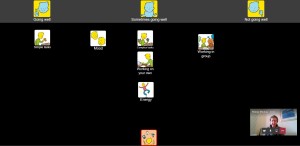
On a personal level we have been testing remote use of Digital Talking Mats amongst the Talking Mats team. We used the coping set from our Health and Wellbeing resource and it has helped our own reflections on how we are feeling about the current restrictions on our lives and the impact it is having on us.
We are aware it is still early days and we do not have a lot of experience of using the digital Talking Mats remotely with people with communication difficulties. It would be good to have a forum for sharing those experiences. We held a virtual meeting on Thursday 23rd April at 10.00 a.m. to do that here is the report of that meeting including a link to a video demonstrating how to set up your digital Talking Mat 20200429 post zoom meeting notes_ no link
Last week was a difficult week as we collectively tried to come to terms with the impact of Corona virus and social distancing on our families, our lives and our work. It was hard to get your head around the life altering actions that we have to take to protect ourselves and the lives of the wider community.
One of the things we in Talking Mats felt we could do was help people with communication difficulties understand what they could and could not do. We developed an easy read resource based on the World Health Organisation recommendations and their traffic light system. It seems to have struck a chord. The response has been amazing with lots of sharing on various social media platforms, currently approaching a reach of 40,000 on Facebook plus more on Twitter, and comments like
‘My 85-year-old mother was not getting it. This has really helped me to have the conversation with her’
‘This is fantastic and not just for people with communication difficulties. Processing and making sense is hard for us all at the moment ‘
‘This will help a lot of very anxious children at the moment
However, things are changing fast and since we made this Easy Read resource on Thursday 19th March, restrictions have tightened so here we made Version 2 on Monday then the Government brought in further restrictions that evening so we developed version 3 20200324 coronvirus easy read v3_. We are hoping that everyone complies and we do not need to do a further update .
We are being advised that the language of social distancing is shifting to physical distancing. It is important for mental health and well-being that we stay connected – just not physically connected. Thank goodness for telephones and the digital age.
Stay safe all
Many thanks to Professor Anna Dunér, Dr Angela Bångsbo and Associate Professor Tina Olsson for this guest blog describing their research project where Talking Mats will be used to enable service users living with dementia to be involved in decisions about their home care services. The project is based on a collaboration between Department of Social Work at the University of Gothenburg, Borås University College and the municipality of Borås, aiming to develop and evaluate the use of Talking Mats.

In Sweden, as in many other developed countries, ideas of consumer choice and personalisation of services have been implemented in social care with the intention of achieving better choice and control as well as increased quality of the services provided for the individual. However, persons living with dementia are at risk of being excluded from the opportunities provided to other groups of service users. Thus, it is important to develop both needs-assessment procedures, and improve the performance of home care services, to enable older people living with dementia continuous choice and control in their everyday living.
We hope that Talking Mats will improve the communication between service users, care managers and staff in eldercare and lead to increased influence of service users over the decisions and planning of their home care services.
During 2020 we have funding for a planning study where we can develop and test the Talking Mats decision aid, identify, translate and test outcome measurements, and refine and test the procedures for a comparative intervention project. In 2021 we hope to attain funding for a three year study.
We have already received valuable advice and information about Talking Mats research from Dr Joan Murphy and hope to keep in contact with her and the Talking Mats team throughout our project.
If you are interested in Talking Mats Research, check out our recent blog with details of how you can get involved with our Virtual Network:
https://www.talkingmats.com/virtual-talking-mats-research-network-launched/
 Online training login
Online training login 

